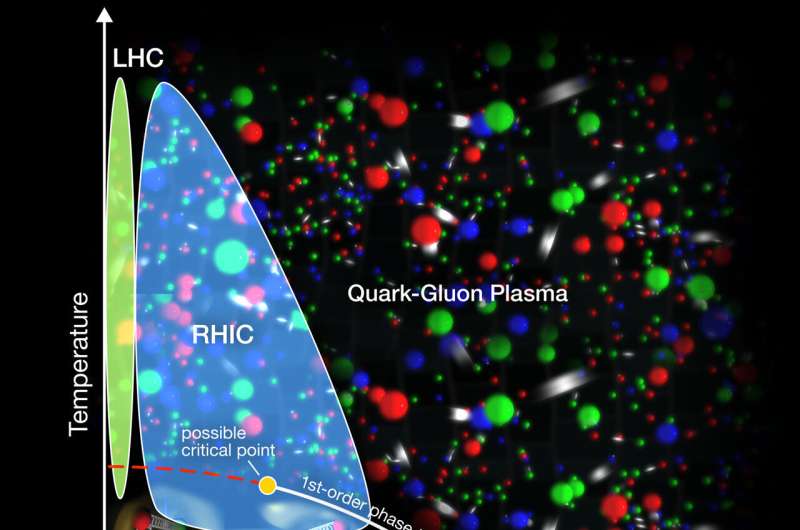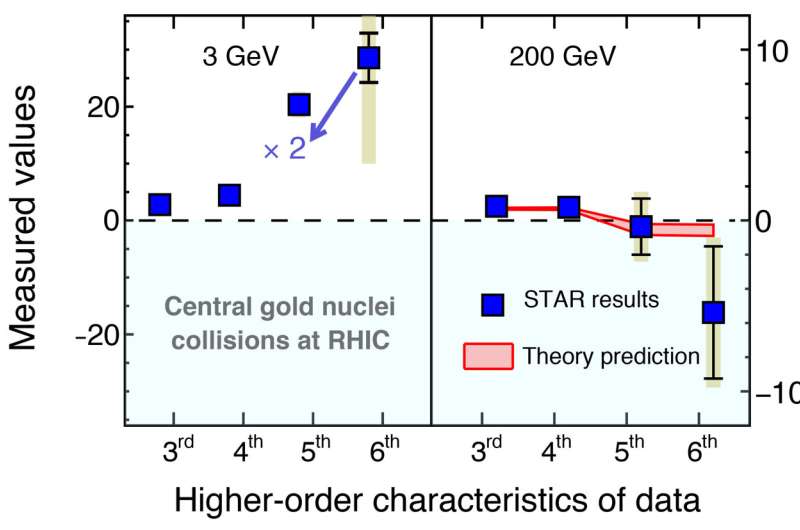This article has been reviewed according to Science X's editorial process and policies. Editors have highlighted the following attributes while ensuring the content's credibility:
fact-checked
peer-reviewed publication
trusted source
proofread
Recognizing a clear sign that quark-gluon plasma production 'turns off' at low energy

Physicists report new evidence that production of an exotic state of matter in collisions of gold nuclei at the Relativistic Heavy Ion Collider (RHIC)—an atom-smasher at the U.S. Department of Energy's (DOE) Brookhaven National Laboratory—can be "turned off" by lowering the collision energy. The "off" signal shows up as a sign change—from negative to positive—in data that describe "higher order" characteristics of the distribution of protons produced in these collisions.
The findings, just published by RHIC's STAR Collaboration in Physical Review Letters, will help physicists map out the conditions of temperature and density under which the exotic matter, known as a quark-gluon plasma (QGP), can exist and identify key features of the phases of nuclear matter.
'Freeing' quarks and gluons
Generating and studying QGP has been a central goal of research at RHIC. Since the collider began operating in 2000, a wide range of measurements have shown that the most energetic smashups of atomic nuclei—at 200 billion electron volts (GeV)—"melt" the boundaries of protons and neutrons to set free, for a fleeting instant, the quarks and gluons that make up ordinary nuclear particles.
Various measurements have shown that the QGP exists down to 19.6 GeV. The new analysis used data collected by RHIC's STAR detector during the first phase of the RHIC Beam Energy Scan to systematically search for the energy at which production of this thermalized state of quarks and gluons is turned off.
"We analyzed 10 collision energies—from a center of mass energy of 200 GeV, which is RHIC's highest collision energy between two gold beams, down to 3 GeV, where one gold beam collides with a stationary gold target," said Ashish Pandav, a student at India's National Institute of Science Education and Research (NISER), now stationed at DOE's Lawrence Berkeley National Laboratory (LBNL). "These data give us the widest coverage to date of the nuclear phase diagram—the map of how nuclear matter changes with temperature and density."
To determine whether a QGP was created at each collision energy the scientists looked at the distribution of protons produced in each collision event.
Systematic analysis
"We measured, event by event, the number of protons minus the number of antiprotons produced, and the distribution of that net-proton production," said Bedangadas Mohanty, a physics professor at NISER. Mohanty and the STAR team analyzed data on a variety of characteristics of the distribution, including the mean value, the variance, how skewed the data were, and so on, up to what are known as 5th and 6th order characteristics.
Then they compared their observations with predictions calculated using the equations of quantum chromodynamics (QCD), the theory that describes the interactions of quarks and gluons, simulated on a discrete spacetime lattice.
"These numerical simulations of QCD have the formation of a thermalized quark-gluon plasma built in, so if the data match the predictions, it is evidence that QGP is present," Mohanty said.
Hierarchical ordering
The QCD calculations predict a hierarchical ordering of the net-proton distribution characteristics—and that certain relationships among these characteristics should all have negative values. The STAR data indicate that these thermodynamic patterns generally persist at all but the lowest collision energy.
"We know at 200 GeV that RHIC collisions create a QGP, but what about the next energy, 62.4 GeV, 54.4 GeV, 39, 27, 19.6?" said Nu Xu, a physicist at LBNL and former spokesperson for STAR. "At all of these energies, we found the predicted hierarchy and negative values—meaning the data at these energies are all consistent with a thermalized QGP."

Below 19.6 GeV, the data continued to match the predictions, though the error bars indicating the range of uncertainty about those measurements were large.
"For these energies, we need more data," Xu said.
But at the lowest energy, 3 GeV, the scientists saw a dramatic shift. The order of the hierarchy among the analyzed characteristics flipped—and so did the sign of the key relationships, from negative to positive.
"This sign change is a robust indication, supported by first-principles calculations, that the formation of a quark-gluon plasma is turned off at RHIC's lowest collision energy," Xu said.
Certainty in the math
The scientists' certainty is driven by the fact that the comparisons they used come from pure mathematical descriptions of the QGP, rather than models based on approximations of the quark-gluon interactions. They liken this "first-principles" approach to solving the simplest equations of classical physics—like Newton's law (force = mass x acceleration) or understanding the impact of velocity on how far you can travel (rate x time = distance).
"In this case, it is solving the interactions of quarks and gluons, using QCD, which has much more complicated equations," Mohanty said.
That work required powerful computers, including at the RHIC and ATLAS Computing Facility (RACF) at Brookhaven Lab, the National Energy Research Scientific Computing Center (NERSC) at LBNL, and the Open Science Grid consortium.
"These computing resources and lattice QCD—an approach for solving the equations that considers quark-gluon interactions on 4D space-time lattice—have enabled great advances in our ability to make precise predictions about the behavior of higher order characteristics of conserved charge distributions in QCD," said Frithjof Karsch, a former Brookhaven Lab theorist now at the University of Bielefeld in Germany, who co-authored a paper on the QCD predictions.
"It is exciting to see these predictions from the first-principles calculations being confirmed by the experimental data at RHIC."
The scientists hope to further strengthen their confidence in their findings and their search for a QGP turn-off point by analyzing data from RHIC's Beam Energy Scan II (BES II). That trove of data will narrow the uncertainty of all the results, especially for the energies below 19.6 GeV.
"From a thermalized system, we see a smooth pattern from 200 GeV to 62 GeV all the way to 19.6. Then we see something 'bumpy' between 20 and 3 GeV," Xu said.
An earlier analysis of fluctuations in net proton production suggested that bumpiness could be an indication of a particular combination of temperature and pressure where the way the QGP is formed from ordinary nuclear matter changes. These results and the addition of data from BES II will help to narrow the search for that so-called critical point.
"It is all related," Xu said.
More information: B. E. Aboona et al, Beam Energy Dependence of Fifth- and Sixth-Order Net-Proton Number Fluctuations in Au+Au Collisions at RHIC, Physical Review Letters (2023). DOI: 10.1103/PhysRevLett.130.082301
Journal information: Physical Review Letters
Provided by Brookhaven National Laboratory





















